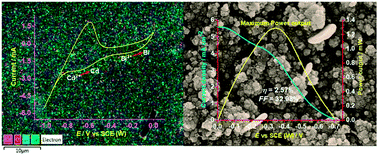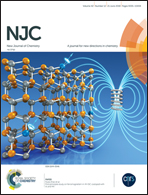Multi-elemental chalcogenide n-BiCdSe films grown under controlled depth voltammetry: improved photo-electrochemical behaviour toward energy conversion†
Abstract
In this study, thin films of composite semiconductor (SC) n-BiCdSe were electrochemically synthesized by periodic voltammetry at room temperature using an aqueous acidic bath containing the respective precursor salts. The well-adherent and uniformly deposited thin films were subjected to optical measurements (UV-vis), scanning electron microscopy (SEM-EDAX) and X-ray diffraction studies to determine the optical properties, structure and morphology of the film matrices. The polycrystalline films were composed of agglomerated particles with spherical geometry, and their size was in the range of ∼30–40 nm. A series of electrochemical techniques were employed to determine the performance output of the films with respect to their photo-electrochemical (PEC) characteristics in a liquid junction solar cell. During fabrication of the films, voltammetric cycles were optimized to obtain the best-performing composite film, which exhibited a maximum photo-conversion efficiency of 2.6% and least photocurrent decay.



 Please wait while we load your content...
Please wait while we load your content...